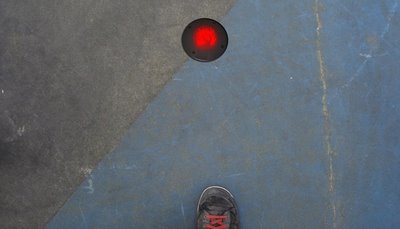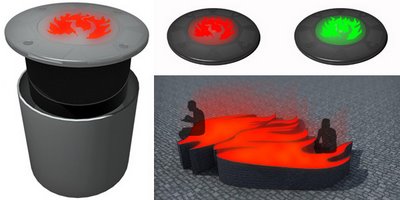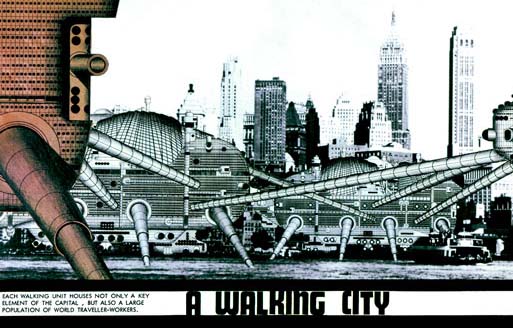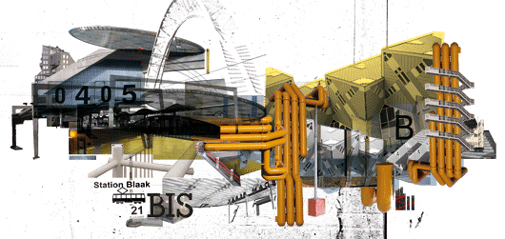 {Brandgrens by West 8: Image via West 8}
{Brandgrens by West 8: Image via West 8}
A project by the Dutch landscape and urban design collective West 8 literally inscribes the limits of the destruction of Rotterdam by Luftwaffe bombers on May 14, 1940. Along the dense urban fabric of the city, famously rebuilt after the disaster, a series of solar-powered LED's mark the true fire limits. From West 8's website:
An iconic image of a flame is incorporated in circular light objects on the ground and in several information stations, that together form the marking. The image of the flame shows a visual connection with Zadkine's statue commemorating the bombing of Rotterdam. The light objects come to life at night when the solar-powered LEDs illuminate the icon. This physical marking of the fire limits is coupled with information about the historic meaning of the bombing, accessible through the information stations and a website.

 {West 8, Embedded LED system, Rotterdam Brandgrens, 2007 (Source: West 8)}
{West 8, Embedded LED system, Rotterdam Brandgrens, 2007 (Source: West 8)}
As noted by A456, the design can be experienced at the intimate pedestrian level, the small lights delineating the end of carnage, pinpointing the experience of local shopkeepers and patrons. On the other, broader scale, is the plan, which shear mass collectively illustrates the power of destruction that occurred on that day.
 {West 8, Rotterdam Brandgrens, Plan, 2007 (Source: West 8)}
{West 8, Rotterdam Brandgrens, Plan, 2007 (Source: West 8)}
A456 also points us to an additional ephemeral memorial for the attack, a Mothership installation entitled The Bombardment Periphery. On the evening on May 14, 2007, the Dutch design collective pointed 128 light fixtures, each rated at about 7000 watts (and curiously referred to as "Spacecannons"), into a low, gray, cloudy sky between 10:45pm and 2:00am.
 {Mothership, Bombardment Periphery, 2007 (Source: Mothership)}
{Mothership, Bombardment Periphery, 2007 (Source: Mothership)}
This installation is quite a bit more dramatic, and cast against the cloudy darkened sky, the light projected tracings of the bomb's paths replicate a cinematic and eery encounter of unimaginable power and fear.
Memorial design is one of the most complicated and challenging projects a designer can take on. So many factors both large and small scale, political and emotional have to be considered to effectively communicate the idea.
I'm personally fond of the unimposing scale of the LED's, which a visitor can experience at leisure, commemorates the fallen and celebrates the strength of the city rebuilt. The Mothership installation is brief, illustrating the awesome experience of that day, but allows the city to remember, and move on.















